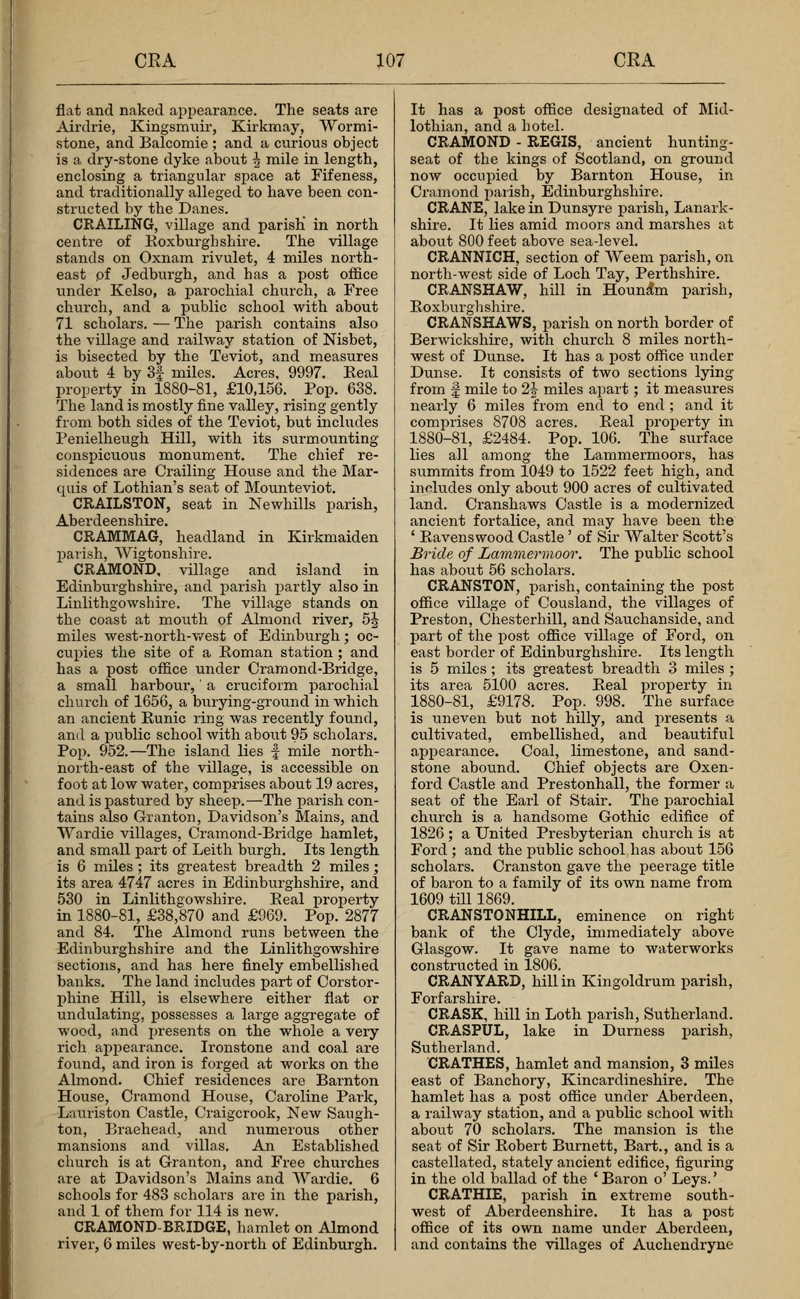CRAILING, village and parish! in north centre of Roxburgh shire. The village stands on Oxnam rivulet, 4 miles north-east of Jedburgh, and has a post office under Kelso, a parochial church, a Free church, and a public school with about 71 scholars. The parish contains also the village and railway station of Nisbet, is bisected by the Teviot, and measures about 4 by 3f miles. Acres, 9997. Real property in 1880-81, 10,156. Pop. 638. The land is mostly fine valley, rising gently from both sides of the Teviot, but includes Penielheugh Hill, with its surmounting conspicuous monument. The chief residences are Crailing House and the Marquis of Lothian's seat of Mounteviot.
CRAILSTON, seat in Newhills parish, Aberdeenshire.
CRAMMAG, headland in Kirkmaiden parish, Wigtonshire.
CRAMOND, village and island in Edinburghshire, and parish partly also in Linlithgowshire. The village stands on the coast at mouth of Almond river, 5J miles west-north-west of Edinburgh ; occupies the site of a Roman station ; and has a post office under Cramond-Bridge, a small harbour, a cruciform parochial church of 1656, a burying-ground in which an ancient Runic ring was recently found, and a public school with about 95 scholars. Pop. 952. The island lies mile north-north-east of the village, is accessible on foot at low water, comprises about 19 acres, and is pastured by sheep. The parish contains also Granton, Davidson's Mains, and Wardie villages, Cramond-Bridge hamlet, and small part of Leith burgh. Its length is 6 miles ; its greatest breadth 2 miles ; its area 4747 acres in Edinburghshire, and 530 in Linlithgowshire. Real property in 1880-81, 38,870 and 969. Pop. 2877 and 84. The Almond runs between the Edinburghshire and the Linlithgowshire sections, and has here finely embellished banks. The land includes part of Corstorphine Hill, is elsewhere either flat or undulating, possesses a large aggregate of wood, and presents on the whole a very rich appearance. Ironstone and coal are found, and iron is forged at works on the Almond. Chief residences are Barnton House, Cramond House, Caroline Park, Lauriston Castle, Craigcrook, New Saughton, Braehead, and numerous other mansions and villas. An Established church is at Granton, and Free churches are at Davidson's Mains and Wardie. 6 schools for 483 scholars are in the parish, and 1 of them for 114 is new.
CRAMOND-BRIDGE, hamlet on Almond river, 6 miles west-by-north of Edinburgh. It has a post office designated of Mid-lothian, and a hotel.
CRAMOND - REGIS, ancient hunting-seat of the kings of Scotland, on ground now occupied by Barnton House, in Cramond parish, Edinburghshire.
CRANE, lake in Dunsyre parish, Lanarkshire. It lies amid moors and marshes at about 800 feet above sea-level.
CRANNICH, section of Weem parish, on north-west side of Loch Tay, Perthshire.
CRANSHAW, hill in Hounlm parish, Roxburghshire.
CRANSHAWS, parish on north border of Berwickshire, with church 8 miles north-west of Dunse. It has a post office under Dunse. It consists of two sections lying from f mile to 2J miles apart ; it measures nearly 6 miles from end to end ; and it comprises 8708 acres. Real property in 1880-81, 2484. Pop. 106. The surface lies all among the Lammermoors, has summits from 1049 to 1522 feet high, and includes only about 900 acres of cultivated land. Cranshaws Castle is a modernized ancient fortalice, and may have been the ' Ravenswood Castle ' of Sir Walter Scott's Bride of Lammermoor. The public school has about 56 scholars.
CRANSTON, parish, containing the post office village of Cousland, the villages of Preston, Chesterhill, and Sauchanside, and part of the post office village of Ford, on east border of Edinburghshire. Its length is 5 miles ; its greatest breadth 3 miles ; its area 5100 acres. Real property in 1880-81, 9178. Pop. 998. The surface is uneven but not hilly, and presents a cultivated, embellished, and beautiful appearance. Coal, limestone, and sand-stone abound. Chief objects are Oxenford Castle and Prestonhall, the former a seat of the Earl of Stair. The parochial church is a handsome Gothic edifice of 1826 ; a United Presbyterian church is at Ford ; and the public school has about 156 scholars. Cranston gave the peerage title of baron to a family of its own name from 1609 till 1869.
CRANSTONHILL, eminence on right bank of the Clyde, immediately above Glasgow. It gave name to waterworks constructed in 1806.
CRANYARD, hill in Kingoldrum parish, Forfarshire.
CRASK, hill in Loth parish, Sutherland.
CRASPUL, lake in Durness parish, Sutherland.
CRATHES, hamlet and mansion, 3 miles east of Banchory, Kincardineshire. The hamlet has a post office under Aberdeen, a railway station, and a public school with about 70 scholars. The mansion is the seat of Sir Robert Burnett, Bart., and is a castellated, stately ancient edifice, figuring in the old ballad of the ' Baron o' Leys.'
CRATHIE, parish in extreme south-west of Aberdeenshire. It has a post office of its own name under Aberdeen, and contains the villages of Auchendryne and Castleton-Braemar, and the royal seat of Balmoral Castle. Its length is 28 miles ; its greatest breadth 15 miles ; its area 182,257 acres. Real property in 1880-81, 14,430. Pop., quoad civilia, 1611 ; quoad sacra, 735. The entire area is the upper part of the basin of the Dee ; the boundary all round, except on the east, is an alpine watershed ; the section around the Dee's sources includes a main portion of Cairngorm Mountains ; and the rest of the surface is an imposing assemblage of lofty upland, picturesque crag, deep glen, and ornate valley. Not less than about 10,500 acres are under wood. The seats, besides Balmoral Castle, are Abergeldie, Invercauld, Mar Lodge, and Corrymulzie Cottage. The parochial church was built in 1806, and contains about 900 sittings. A Free church is near the parochial one ; and Established, Free, and Roman Catholic churches are in Castleton. 7 schools are in the parish, and have accommodation for 430 scholars.

